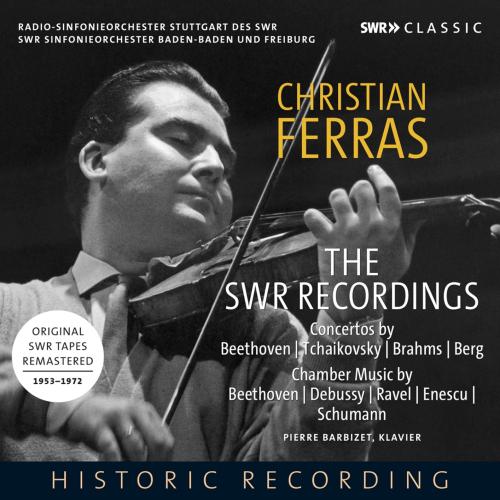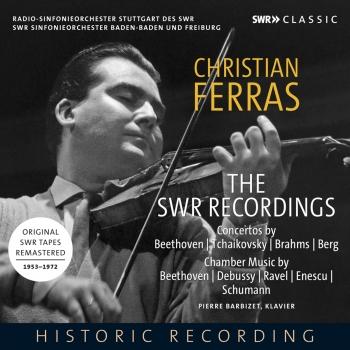
Beethoven, Tchaikovsky & Others: Violin Sonatas & Concertos Christian Ferras, Pierre Barbizet, Stuttgart Radio Symphony Orchestra, SWR Sinfonieorchester Baden-Baden und Freiburg
Album info
Album-Release:
2022
HRA-Release:
10.06.2022
Label: SWR Classic
Genre: Classical
Subgenre: Concertos
Composer: Ludwig van Beethoven (1770-1827), Alban Berg (1885-1935)
Album including Album cover Booklet (PDF)
- Ludwig van Beethoven (1770 - 1827): Violin Sonata No. 9 in A Major, Op. 47 "Kreutzer":
- 1 Beethoven: Violin Sonata No. 9 in A Major, Op. 47 "Kreutzer": I. Adagio sostenuto 11:36
- 2 Beethoven: Violin Sonata No. 9 in A Major, Op. 47 "Kreutzer": II. Andante con variazioni 13:11
- 3 Beethoven: Violin Sonata No. 9 in A Major, Op. 47 "Kreutzer": III. Finale 07:02
- Claude Debussy (1862 - 1918): Violin Sonata in G Minor, L. 140:
- 4 Debussy: Violin Sonata in G Minor, L. 140: I. Allegro vivo 04:35
- 5 Debussy: Violin Sonata in G Minor, L. 140: II. Intermède. Fantasque et léger 04:13
- 6 Debussy: Violin Sonata in G Minor, L. 140: III. Finale. Très animé 03:49
- Maurice Ravel (1875 - 1937): Tzigane, M. 76:
- 7 Ravel: Tzigane, M. 76 09:42
- Ludwig van Beethoven: Violin Sonata No. 5 in F Major, Op. 24:
- 8 Beethoven: Violin Sonata No. 5 in F Major, Op. 24: I. Allegro 07:16
- 9 Beethoven: Violin Sonata No. 5 in F Major, Op. 24: II. Adagio molto espressivo 06:02
- 10 Beethoven: Violin Sonata No. 5 in F Major, Op. 24: III. Scherzo. Allegro molto 01:10
- 11 Beethoven: Violin Sonata No. 5 in F Major, Op. 24: IV. Rondo. Allegro ma non troppo 06:14
- George Enescu (1881 - 1955): Violin Sonata No. 3 in A Minor, Op. 25:
- 12 Enescu: Violin Sonata No. 3 in A Minor, Op. 25: I. Moderato malinconico 06:51
- 13 Enescu: Violin Sonata No. 3 in A Minor, Op. 25: II. Andante sostenuto e misterioso 06:48
- 14 Enescu: Violin Sonata No. 3 in A Minor, Op. 25: III. Allegro con brio, ma non troppo mosso 06:46
- Robert Schumann (1810 - 1856): Violin Sonata No. 2 in D Minor, Op. 121:
- 15 Schumann: Violin Sonata No. 2 in D Minor, Op. 121: I. Ziemlich langsam 10:26
- 16 Schumann: Violin Sonata No. 2 in D Minor, Op. 121: II. Sehr lebhaft 04:02
- 17 Schumann: Violin Sonata No. 2 in D Minor, Op. 121: III. Leise, einfach 06:49
- 18 Schumann: Violin Sonata No. 2 in D Minor, Op. 121: IV. Bewegt 06:23
- Ludwig van Beethoven: Violin Concerto in D Major, Op. 61:
- 19 Beethoven: Violin Concerto in D Major, Op. 61: I. Allegro ma non troppo 24:13
- 20 Beethoven: Violin Concerto in D Major, Op. 61: II. Larghetto 09:21
- 21 Beethoven: Violin Concerto in D Major, Op. 61: III. Rondo. Allegro 10:19
- Pyotr Ilyich Tchaikovsky (1840 - 1893): Violin Concerto in D Major, Op. 35, TH 59:
- 22 Tchaikovsky: Violin Concerto in D Major, Op. 35, TH 59: I. Allegro moderato 17:55
- 23 Tchaikovsky: Violin Concerto in D Major, Op. 35, TH 59: II. Canzonetta. Andante 06:34
- 24 Tchaikovsky: Violin Concerto in D Major, Op. 35, TH 59: III. Finale. Allegro vivacissimo 08:53
- Johannes Brahms (1833 - 1897): Violin Concerto in D Major, Op. 77:
- 25 Brahms: Violin Concerto in D Major, Op. 77: I. Allegro non troppo 22:15
- 26 Brahms: Violin Concerto in D Major, Op. 77: II. Adagio 10:21
- 27 Brahms: Violin Concerto in D Major, Op. 77: III. Allegro giocoso, ma non troppo vivace 08:10
- Alban Berg (1885 - 1935): Violin Concerto "To the Memory of an Angel":
- 28 Berg: Violin Concerto "To the Memory of an Angel": I. Andante (Live) 10:16
- 29 Berg: Violin Concerto "To the Memory of an Angel": II. Allegro (Live) 13:50
Info for Beethoven, Tchaikovsky & Others: Violin Sonatas & Concertos
Christian Ferras will most likely be remembered as the violinist who was filmed shedding tears at the end of the slow movement of Sibelius’s Concerto in 1965, and who, after a dramatic downturn in his career, took his own life at the age of 49. And, of course, as the child prodigy from the French provinces who became – at the height of his fame – Herbert von Karajan’s favorite violinist. His artistic personality was shaped by his utter, though humble, devotion to the music, demonstrated by his appropriate yet lively tone, elegant bowing, effervescent, energetic fingering and considered phrasing. The recordings of Christian Ferras with pianist Pierre Barbizet are of the utmost importance, with the musicians forming an inimitable partnership. The concertos in this collection showcase the violinist as a captivating soloist – Müller-Kray follows his every move in the Beethoven and Tchaikovsky with dynamic sensitivity, Gielen’s analytical expertise within the Berg is unrivalled and Ferras’s partnership with Blomstedt results in a profound interpretation of the Brahms.
Christian Ferras, violin
Pierre Barbizet, piano
Stuttgart Radio Symphony Orchestra
SWR Sinfonieorchester Baden-Baden und Freiburg
Christian Ferras
The recordings of violinist Christian Ferras demonstrate a curious duality of style: on the one hand a tightly wound, somewhat harsh, brassy sound with nagging and intrusive vibrato (found particularly in some of his later work); on the other, a warmer, more old-fashioned, Romantic approach, with conspicuous portamenti and tempo rubato. To some extent, chronology plays a part—recordings before 1960 tend towards the latter style—but this is not clear-cut. It may be that Ferras consciously began to impose a modernist style on Classical works in keeping with current trends (which would explain why his 1964 Sibelius Concerto has stylistic traits in common with his 1951 Beethoven); but however this may be, a detailed study of Ferras’s whole discography would give fascinating insights into post-war stylistic change in established repertoire. Ferras’s struggle with depression that, tragically, led to his suicide at the age of forty nine, may also be a factor in his changeable interpretative approach.
His first violin lessons were with his father, a pupil of Marcel Chailley, and led to prodigious success at the Nice and Paris Conservatoires. After graduating with a double premier prix aged thirteen, Ferras gained performing experience with the Pasdeloup Orchestra. He also benefitted from George Enescu’s mentoring through his early career. During the late 1940s and early 1950s he undertook an overwhelming number of prominent appearances, won international prizes and gave world premières, working with many illustrious musicians including pianist Pierre Barbizet, his famous duo partner for some years.
A performer who (like most of his peers) made few stylistic concessions to compositional period, Ferras recorded Bach’s Double Violin Concerto with Menuhin in 1958 in a tonally-heavy mould with little attention to small-scale phrasing and a certain undulation of tone in slurred passages (the so-called ‘Menuhin slur’). Ferras’s sound is brighter than Menuhin’s muted tones, but the two soloists are otherwise equally matched. His 1951 Beethoven Concerto is also Romantically delivered with a characteristic warmth and heaviness, and a much-modified use of fingerings that seem to originate with Joachim. The 1959 performances of Bruch’s Concerto No. 1 and Lalo’s Symphonie Espagnole display an extraordinarily fast, intense vibrato which sounds curious today, but both have variability and therefore humanity in their rendition and the Bruch is brought alive by a well-connected slow movement and a fiery finale with perfectly accurate, explosive double-stopping at the start. The renown of these two recordings is apparent in the price of second-hand copies on LP, selling today for hundreds of pounds.
Although Ferras’s large discography is mainly of seminal Romantic works, he became particularly known for his numerous performances of Berg’s Violin Concerto, which he recorded with Ernest Ansermet in 1957. This is a curious reading, in many ways, of a work that is often played with a steely certainty and almost mechanistic intensity; here Ferras unusually stresses smaller-scale phrasing and, though the recorded sound is rather dim, there is a slightly halting and vulnerable quality which makes it an emotionally enticing prospect.
Ferras also recorded from the standard duo sonata repertoire, including a slightly brusque Beethoven ‘Spring’ Sonata with his trusted partner Pierre Barbizet. This, in 1958, is a fascinating glimpse into the style and taste of the time. Regularity of accentuation and tempo, and a rather dry and immediate recording quality are immediately apparent, but the work survives the objective treatment well and Ferras’s discipline is admirable.
Whilst some of his playing is an acquired taste, and the double-sided nature of his interpretations at times rather perplexing, there is a directness and sincerity to all Ferras’s performances which make them historically valuable.
SWR Sinfonieorchester Baden-Baden und Freiburg
As it has always done, the SWR Symphony Orchestra Baden-Baden and Freiburg continues to provide space for new movements, new guests, and new works. The years 2014/15 took the musicians to the renowned festivals in Berlin, Lucerne, Vienna and Paris. At the Opéra Dijon they played Alban Berg's "Wozzeck", in Baden-Baden a multi-part focus on the music of Pierre Boulez on the occasion of his 90th birthday. The orchestra kicked off 2015 in Freiburg with the Beethoven Plus Festival, which confronts Beethoven's major works with contemporary symphonic music. When François-Xavier Roth took up his post as principal conductor, he did so at the final concert of the 2011 Donaueschingen Festival—clearly signalling the significance he too places on new music. Ever since the festival's reestablishment in 1950, it has been inextricably linked with the SWR Orchestra Baden-Baden and Freiburg. The orchestra has premiered approximately 400 compositions at the festival and made music history with the works of Hans Werner Henze and Bernd Alois Zimmermann, Karlheinz Stockhausen and Olivier Messiaen, Helmut Lachenmann and Wolfgang Rihm. Since its establishment in 1946, it attracts in equal measure internationally acclaimed conductors and soloists as well as musical ambassadors, both nationally and internationally, from Hamburg to Madrid, Berlin to New York. The orchestra's discography includes over 600 works, spanning three centuries. The driving force behind these many activities have been, and continue to be, its distinguished principal conductors—from Hans Rosbaud and Ernest Bour to Michael Gielen, Sylvain Cambreling, and François-Xavier Roth—all of whom have guided and shaped an orchestra that, in more than six decades of embracing exceptional challenges, has achieved a degree of flexibility and mastery seldom found anywhere else.
Booklet for Beethoven, Tchaikovsky & Others: Violin Sonatas & Concertos










